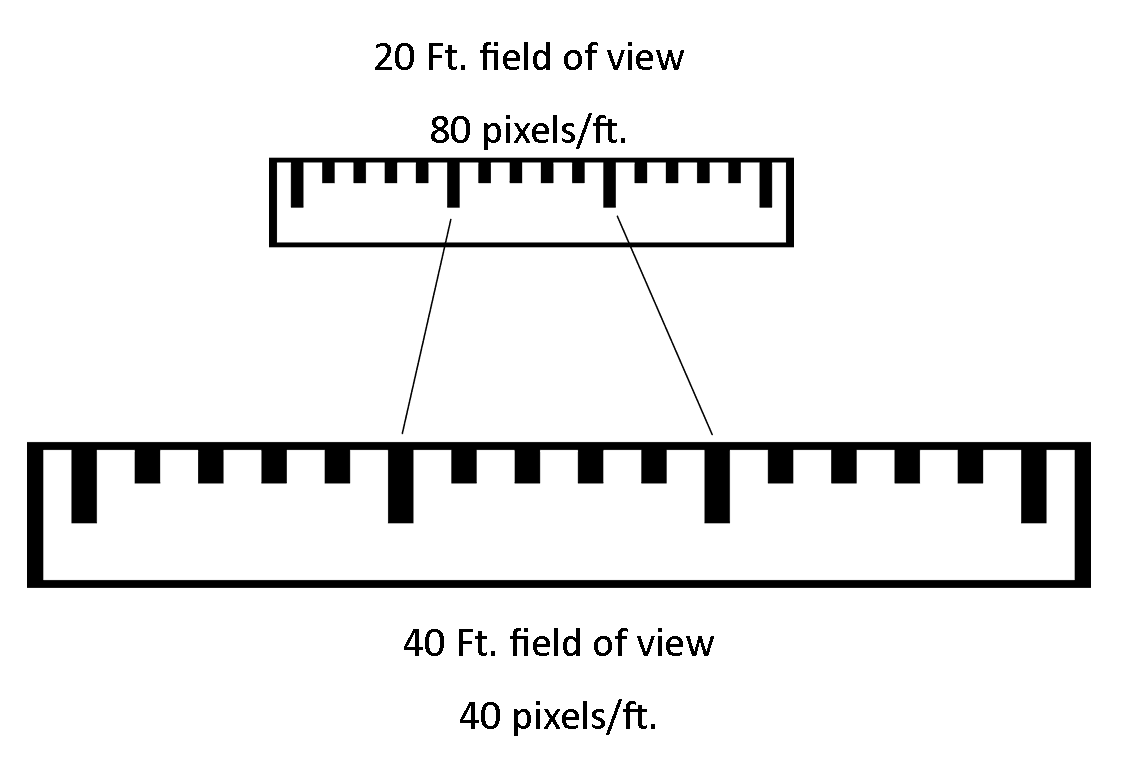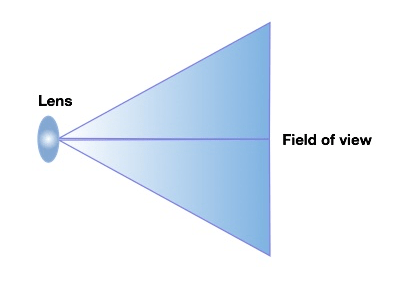What Type of Camera Do I Need?
By Bob Mesnik

There was a break-in at your warehouse, but, you were prepared. Last month you installed a complete IP camera system. Now you have evidence you can share with the police.
Uh oh! You can’t identify their faces. There are two people in the warehouse, but you can’t tell who they are. Ugh! What did you do wrong? You have just discovered that having a surveillance camera, is not enough. You have to have the right resolution camera and the right lens.
This article reviews what you need to assure you meet your security objective.
The Right IP Camera Resolution
The correct camera for your surveillance application has the resolution you need and the right lens to frame the shot. The wider the view the more resolution you will need to see all the details. Take a look at the ruler below. When you use a wider angle lens, the field of view widens and the distance between pixels increases, so the pixels/ft. is less.

What’s the right resolution to identify a person’s face? To calculate the right resolution, you need to know two things. First, you need at least 80 pixels of horizontal resolution per foot. Second, you need to know the width of the horizontal field of view. Once you know this, you can calculate the right resolution and lens.
Here’s an example, suppose I want to see an area that’s 20 ft (6 m). wide. Since I need 80 pixels per ft. across, I need at least 20 ft. x 80 pixels/ft. = 1600 pixels across the total field of view. Therefore, I need to select a camera with a horizontal resolution of at least 1600 pixels. Let’s see what cameras are available. Sony has the 1-megapixel (720p) camera, SNC-EM600, that provides 1280 x 1024 pixels, while the Samsung SND-6084, 2-megapixel camera (1080p) provides 1920 x 1080 pixels of resolution. Since the 2-megapixel camera provides over 1600 horizontal pixels, this is the right choice.
What if you want to see a larger area? In this case, you will need a higher resolution camera. The wider the field of view, the more resolution you will require. If you double the field of view then you will need twice as much horizontal resolution.
For example, if you use one of the latest 4K IP cameras, such as the Samsung PNO-9080R, you can identify a person’s face in a field of view that’s about 48 ft. (14.6 m) wide. This camera provides a resolution of 3840 x 2160 pixels. The maximum field of view is calculated by dividing the total number of horizontal pixels (3840 pixels) by the number of pixels/ft (in this case 80 pixels/ft.).
For more information about how much resolution you need, take a look at our article, What IP Camera Resolution Do You Need?
The Lens defines the Field of View

The camera lens must be selected so that you get the right field of view at a specific distance. In the previous example, we assumed a field of view of 20 ft. The lens defines the field of view.
To calculate the lens angle, we need to know the distance from the camera. The closer we are, the wider the lens angle. The further away, the narrower the lens angle.
Here’s an example: If the area we want to see (field of view) is 30 ft away, and the field of view is 20 ft. we can calculate the lens angle required. To do this we use a right triangle and some trigonometry.
The camera lens must be selected so that you get the right field of view at a specific distance. In the previous example, we assumed a field of view of 20 ft. The lens defines the field of view.
To calculate the lens angle, we need to know the distance from the camera. The closer we are, the wider the lens angle. The further away, the narrower the lens angle.
Here’s an example: If the area we want to see (field of view) is 30 ft away, and the field of view is 20 ft. we can calculate the lens angle required. To do this we use a right triangle and some trigonometry.

Using the triangle, the hypotenuse (c) equals 30 ft. and the Opposite side (a) is ½ our field of view or 10 ft. To make life easier, go to the triangle calculator and enter the values for “c”, and “a” . The calculator says that the angle “A” is 19.5 degrees. Remember that we have to double the angle since this is only one-half of the field of view. The lens angle should be 39 degrees.
We need a camera that has a lens that can be adjusted to 39 degrees. As an example, the Samsung SND-5084 has an adjustable lens that ranges from 93.4°(Wide) ~ 33.1° (Tele), so it will be a good choice for this application.
What Specifications Are Important
The resolution and lens are two important factors to consider, but what other IP camera system specifications are important? Other things include low light sensitivity, frame rate, wide dynamic range, and the capability of the video recording system. Take a look at our article, IP Camera Specifications, What’s Important for more details about all the things to consider.
Need some help selecting the right IP camera, just contact us at 1-800-431-1658 in the USA, or 914-944-3425 everywhere else, or use our contact form.